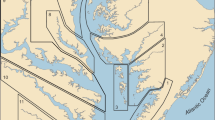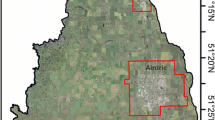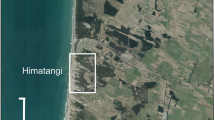Abstract
Historical and geospatial data were used to identify the relationships between water levels, wetland vegetation, littoral drift of sediments, and the condition of a protective barrier beach at Metzger Marsh, a coastal wetland in western Lake Erie, to enhance and guide a joint federal and state wetland restoration project. Eleven sets of large-scale aerial photographs dating from 1940 through 1994 were interpreted to delineate major vegetation types and boundaries of the barrier beach. A geographic information system (GIS) was then used to digitize the data and talculate the vegetated area and length of barrier beach. Supplemented by paleoecological and sedimentological analyses, aerial photographic interpretation revealed that Metzger Marsh was once a drowned-river-mouth wetland dominated by sedges and protected by a sand barrier beach. Extremely high water levels, storm events, and reduction of sediments in the littoral drift contributed to the complete destruction of the barrier beach in 1973 and prevented its recovery. The extent of wetland vegetation, correlated to water levels and condition of the barrier beach, decreased from a high of 108 ha in 1940 to a low of 33 ha in 1994. The lack of an adequate sediment supply and low probability of a period of extremely low lake levels in the near future made natural reestablishment of the barrier beach and wetland vegetation unlikely. Therefore, the federal and state managers chose to construct a dike to replace the protective barrier beach. Recommendations stemming from this historical analysis, however, resulted in the incorporation of a water-control structure in the dike that will retain a hydrologic connection between wetland and lake. Management of the wetland will seek to mimic processes natural to the wetland type identified by this analysis.
Similar content being viewed by others
Literature Cited
Anderson, R. R. and F. J. Wobber. 1973. Wetlands mapping in New Jersey. Photogrammetric Engineering 39:353–358.
Bradshaw, A. D. 1996. Underlying principles of restoration. Canadian Journal of Fisheries and Aquatic Sciences 53:3–9.
Brown, W. W. 1978. Wetland mapping in New Jersey and New York. Photogrammetric Engineering and Remote Sensing 44:303–314.
Campbell, L. W. and C. Gavin. 1995. The Marshes of Southwestern Lake Erie. Ohio University Press Athens, OH, USA.
Carmel, C. and R. Kadmon. 1998. Computerized classification of Mediterranean vegetation using panchromatic aerial photographs. Journal of Vegetation Science 9:445–454.
Farney, R. A. and T. A. Bookhout. 1982. Vegetation changes in a Lake Erie marsh (Winous Point, Ottawa County, Ohio) during high water years. Ohio Journal of Science 82:103–107.
Foote, A. L. and J. A. Kadlec. 1988. Effects of wave energy on plant establishment in shallow lacustrine wetlands. Journal of Freshwater Ecology 4:523–532.
Gammon, P. T. and V. Carter. 1979. Vegetation mapping with seasonal color infrared photographs. Photogrammetric Engineering and Remote Sensing 45:87–97.
Gorman, L., A. Morang, and R. Larson. 1998. Monitoring the coastal environment; part IV: mapping, shoreline changes, and bathymetric analysis. Journal of Coastal Research 14:61–92.
Gottgens, J. E., B. P. Swartz, R. W. Kroll, and M. Eboch. 1998. Longterm GIS-based records of habitat changes in a Lake Erie coastal marsh. Wetlands Ecology and Management 6:5–17.
Harris, S. W. and W. H. Marshall. 1963. Ecology of water-level manipulations on a northern marsh. Ecology 44:331–343.
Herdendorf, C. E. 1975. Shoreline changes of lakes Eric and Ontario with special reference to currents, sediment transport, and shore erosion. p. 43–76.In R. A. Sweeney. (ed.) Proceedings of the Conference of Changes in the Physical Aspects of Lakes Erie and Ontario. Bulletin of the Buffalo Society of Natural Sciences, Buffalo, NY, USA.
Herdendorf, C. E. 1987. The ecology of the coastal marshes of western Lake Erie: a community profile. U. S. Fish and Wildlife Service, Washington, DC, USA. Biological Report 85 (7.9)
Jackson, S. T. and D. K. Singer. 1995. Report on pollen and macrofossils analyses of Metzger Marsh sediment cores. Northern Arizona University, Department of Biological Sciences, Flagstaff, AZ, USA.
Kaatz, M. R. 1955. The Black Swamp: a study in historical geography. Annals of the Association of American Geographers 45:1–35.
Keddy, P. A. and A. A. Reznicek. 1986. Great Lakes vegetation dynamics: the role of fluctuating water levels and buried seeds. Journal of Great Lakes Research 12:25–36.
Lamson, A. C. 1877. Survey of the n. & n. w. lakes, Lake Erie. National Archives, Washington, DC, USA. U. S. Lake Survey Sheet 1-712.
Lillesand, T. M. and R. W. Kiefer. 1987. Remote Sensing and Image Interpretation. Second Edition. John Wiley & Sons, New York, NY, USA.
Lyon, J. G. and R. D. Drobney. 1984. Lake level effects as measured from aerial photos. Journal of Surveying Engineering 110:103–111.
Mackey, S. D. and D. A. Foye. 1998. Relationship between sediment supply, barrier systems, and wetland loss in the Western Basin of Lake Erie—a conceptual model. Geological Society of America Abstracts with Programs 30:58.
Maynard, L. and D. A. Wilcox. 1997. Coastal wetlands of the Great Lakes. State of the Lakes Ecosystem Conference ’96. Environment Canada and U. S. Environmental Protection Agency. Washington, DC, USA. EPA 905-R-97-015b.
McDonald, M. E. 1955. Cause and effects of a die-off of emergent vegetation. Journal of Wildlife Management 19:24–35.
Naesset, E. 1997. Positional accuracy of boundarics between clearcuts and mature forest stands delineated by means of aerial photointerpretation. Canadian Journal of Forest Research 28:368–374.
NOAA. 1992a. Great Lakes Water Levels 1860–1990. U.S. Department of Commerce. National Occanic and Atmospheric Administration. Rockville, MD, USA.
NOAA. 1992b. Great Lakes Water Levels. 1991. U.S. Department of Commerce, National Occanic and Atmospheric Administration. Rockville, MD, USA.
NOAA. 1993. Great Lakes Water Levels. 1992. U. S. Department of Commerce, National Oceanic and Atmospheric Administration. Rockville, MD, USA.
NOAA. 1994. Great Lakes Water Levels. 1993. U.S. Department of Commerce, National Oceanic and Atmospheric Administration. Rockville, MD, USA.
NOAA. 1995. Great Lakes Water Levels, 1994. U.S. Department to Commerce, National Oceanic and Atmospheric Administration. Rockville, MD, USA.
Owens, T. and K. D. Hop. 1995. Long Term Resource Monitoring Program standard operating procedures: Field station photointerpretation. National Biological Service, Environmental Management Technical Center, Onalaska, WI, USA. LTRMP 95-P008-2.
Remillard, M. M. and R. A. Welch. 1993. GIS technologies for aquatic macrophyte studies: modeling applications. Landscape Ecology 8:163–175.
Savoy, D. D. 1956. Sedimentary processes along the Lake Erie shore at Magee Marsh, Ohio. M. S. Thesis. Ohio State University, Columbus, OH, USA.
Schneider, W. J. 1968. Color photographs for water resources studies. Photogrammetric Engineering 34:257–262.
Scher, J. S. and P. T. Tueller. 1973. Color aerial photos for marshland. Photogrammetric Engineering 39:489–499.
Shay, J. M., P. M. J. de Geus, and M. R. M. Kapinga. 1999. Changes in shoreline vegetation over a 50-year period in the Delta Marsh, Manitoba in response to water levels. Wetlands 19:413–425.
Silvester, R. and J. R. C. Hsu. 1991. New and old ideas in coastal sedimentation. Reviews in Aquatic Sciences 4:375–410.
Spence, D. H. N.. 1982. The zonation of plants in freshwater lakes. Advances in Ecological Research 12:37–124.
Steedman, R. J., T. H. Whillans, A. P. Bchm, K. E. Bray, K. I. Cullis, M. M. Holland, S. J. Stoddart, and R. J. White. 1996. Use of historical information for conservation and restoration of Great Lakes aquatic habitat. Canadian Journal of Fisheries and Aquatic Sciences 53:415–423.
Stuckey, R. L. 1989. Western Lake Erie, aquatic and wetland vascular-plant flora: its origin and change. p. 205–256.In K. A. Krieger (ed.) Lake Erie Estuarine Systems: Issues, Resources. Status, and Management. NOAA Estuary-of-the-Month Seminar Series No. 14, Washington, DC, USA.
Teng, W. L., E. R. Loew, D. I. Ross, V. G. Zsilinszky C. P. Lo, W. R. Philipson, W. D. Philpot, and S. A. Morain. 1997. Fundamentals of photographic interpretation. p. 49–113.In W. R. Philipsons (ed.) Manual of Photographic Interpretation. Second Edition. American Society for Photogrammetry and Remote Sensing, Bethesda, MD, USA.
Thompson, T. A. and S. J. Bacdke. 1997. Strand-plain evidence for late Holocene lake-level variations in Lake Michigan. Geological Society of America Bulletin 109:666–682.
Thompson, T. A. and D. A. Wilcox. 1991. A reconnaissance investigation of the geology of Metzger Marsh and recommendations for study. Indiana Geological Survey. Bloomington, IN, USA.
Towar, F. M. 1877. Survey of the n. & n. w. lakes. Lake Erie. National Archives, Washington, DC, USA. U. S. Lake Survey Sheet 1–711.
Trimble Navigation Limited. 1997. Characterizing Accuracy of Trimble Pathfinder Mapping Receivers. Trimble Navigation Limited, Sunnyvale, CA, USA. Docament number 101.
USFWS. 1986. North American Waterfowl Management Plan. U. S. Fish and Wildlife Service, Publications Unit. Arlington, VA, USA.
USFWS. 1994. Update to the North American Waterfowl Management Plan, Expanding the Commitment. U.S., Fish and Wildlife Service, Publications Unit. Arlington, VA, USA.
van der Valk, A. G. 1981. Succession in wetlands: a Gleasonian approach. Ecology 62:688–696.
van der Valk, A. G., L. Squires, and C. H. Welling. 1994. Assessing the impacts of an increase in water level on wetland vegetation. Ecological Applications 4:525–534.
Welch, R., M. Madden Remillard, and R. B. Slack. 1988. Remote sensing and geographic information system techniques for aquatic resource evaluation. Photogrammetric Engineering and Remote Sensing 54:177–185.
Welch, R., M. Remillard, and J. Alberts. 1992. Integration of GPS. remote sensing, and GIS techniques for coastal resource management. Photogrammetric. Engineering and Remote Sensing 58: 1571–1578.
Welch, R., M. Remillard, and R. F. Doren. 1995. GIS database development for south Florida’s national parks and preserves. Photogrammetric Engineering and Remote Sensing 61:1371–1381.
Wilcox, D. A. and J. E. Meeker. 1991. Disturbance effects on aquatic vegetation in regulated and unregulated lakes in northern Minnesota. Canadian Journal of Botany 69:1542–1551.
Wilcox, D. A. and T. H. Whillans. 1990. Techniques for restoration of disturbed coastal wetlands of the Great Lakes. Wetlands 19: 835–857.
Williams, D. C. and J. G. Lyon. 1995. Use of a geographic information system database to measure and evaluate wetland changes in the St. Marys River, Michigan. p. 125–139.In J. G. Lyon and J. McCarthy (eds.) Wetland and Environmental Applications of GIS. Lewis Publishers, Boca Raton, FL, USA.
Zar, J. H. 1984. Biostatistical Analysis (Second Edition), Prentice Hall, Englewood Cliffs, NJ, USA.
Zellmer, J. T. and S. M. Eastman. 1997. Incorporation of historical aerial photographs and land-use information into environmental site assessments. Environmental and Engineering Geoscience 3: 431–441.
Author information
Authors and Affiliations
Rights and permissions
About this article
Cite this article
Kowalski, K.P., Wilcox, D.A. Use of historical and geospatial data to guide the restoration of a Lake Erie coastal marsh. Wetlands 19, 858–868 (1999). https://doi.org/10.1007/BF03161788
Received:
Revised:
Accepted:
Issue Date:
DOI: https://doi.org/10.1007/BF03161788




